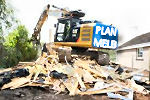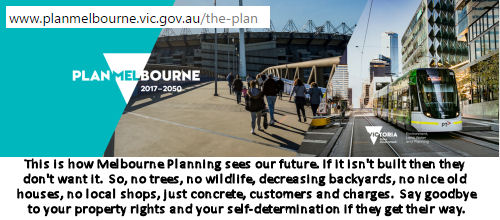Planning Dictators 2017:Last chance to stop Melbourne at 8million plus before all your rights are stripped

 Planning Backlash has been alerted that the Labor government now is letting a [confidential, restricted] tender for the private sector to rewrite the entire Victorian planning system including a new draft planning scheme and new content for zones and overlays. It is designed to ‘cut red tape’, reduce regulation and introduce code assessment of increasingly significant planning applications. This involves removing the need for permits, resident notification, rights of objection and appeal. Property and professional groups dominate the technical and advisory groups for the process. Residents are not represented. . You are being denied natural justice with loss of process for your involvement. Your property rights are under threat. This article has been adapted from a Planning Backlash document [1] received from a planning professional who prefers not to be named, presumably for fear of repercussions within this lockstep industry. Planning Backlash has scheduled a demonstration on the steps of parliament for 8 June 2017 on the steps of Victoria's Parliament at 1pm.
Planning Backlash has been alerted that the Labor government now is letting a [confidential, restricted] tender for the private sector to rewrite the entire Victorian planning system including a new draft planning scheme and new content for zones and overlays. It is designed to ‘cut red tape’, reduce regulation and introduce code assessment of increasingly significant planning applications. This involves removing the need for permits, resident notification, rights of objection and appeal. Property and professional groups dominate the technical and advisory groups for the process. Residents are not represented. . You are being denied natural justice with loss of process for your involvement. Your property rights are under threat. This article has been adapted from a Planning Backlash document [1] received from a planning professional who prefers not to be named, presumably for fear of repercussions within this lockstep industry. Planning Backlash has scheduled a demonstration on the steps of parliament for 8 June 2017 on the steps of Victoria's Parliament at 1pm.

This year, 2017, will decide Melbourne’s future. The State government is locking residents and local government out of decision making while providing massive benefits to the development industry. It is changing Melbourne for the worse.
With a State election due next year, residents can make their voices heard in the public interest. Many electorates are marginal and election results susceptible to strong resident action.
The following changes to planning law are alarming and will have massive consequences.
Residential zones
The government has substantially altered the previous Liberal-coalition government’s residential zones which resident groups had so strongly supported.
The Neighbourhood Residential Zone (NRZ) which covers much of Melbourne’s heritage housing is substantially weakened by allowing multi-unit construction (previously banned) and raising the mandatory maximum height from 8 to 9 metres.
The General Residential Zone (GRZ), the main residential zone, is also weakened. A discretionary 9 metre height limit becomes a mandatory limit of 11 metres. However, many councils had introduced mandatory schedules of 9 metres so the increased height often weakens the zone.
Huge loss of gardens, vegetation
A new Garden Area must be set aside reserving as garden between 25-35% of a lot upon subdivision. But this is a subterfuge. It applies only to new lots above 400 sq.mt. Most new multi-unit lots will be less than this so the garden area will not apply
The NRZ covers only 12% of land in Melbourne –wrecking amenity and heritage there has a high cost but makes only a minor contribution to Melbourne’s new housing needs. Why would a government bother? Planning Minister, Richard Wynne, suggested an answer in a December 2016 parliamentary exchange when he told residents “I will get you fixed, no problem at all”.
VicSmart and heritage
VicSmart is a fast-track planning approvals system requiring assessment within 10 days. Labor opposed its introduction [Ed.when in opposition ?] but now proposes to double its use from the current 7% of all applications, probably eventually up to 30%. More and more permit requirements will be removed including for commercial zones to ‘streamline’ the planning system.
Senseless destruction of retail strip centres compounds construction/destruction activity when there is no need
Melbourne’s heritage retail strip centres and Mixed Use zone are being radically redeveloped into medium and high rise apartments. These are areas of state significance, essential to Melbourne’s liveability and its economic performance. It makes no sense to destroy them especially while massive redevelopment is occurring around them on infill sites. However, Mr Wynne refuses to protect them or even to introduce mandatory height controls.
"Smart Planning": Privatising the planning system; residents' rights and democracy denied

In opposition, Labor opposed deregulation of the planning system but in government now it is pushing development facilitation to new extremes.
The government now is letting a [confidential and restricted] tender for the private sector to rewrite the entire Victorian planning system including a new draft planning scheme and new content for zones and overlays.
It is designed to ‘cut red tape’, reduce regulation and introduce code assessment of increasingly significant planning applications. This involves removing the need for permits, resident notification, rights of objection and appeal. Property and professional groups dominate the technical and advisory groups for the process. Residents are not represented.
This is only smart planning to the property industry contributing $8 billion annually to the government in land related taxes. As the Property Council said: Smart Planning “is exactly what the doctor ordered”.
It is putting the fox in charge of the hen house!
Central City and Southbank
Melbourne’s central business district was once one of the great Victorian treasures. It is rapidly being lost to some of the world’s densest high rise development, in places up to 4-10 times the density of Hong Kong and Manhattan.
In 2016, Mr Wynne rejected the advice of his own independent panel to control height in the CBD and Southbank, instead introducing one of the world’s highest density ratios and providing big incentives for ‘hyper-dense’ development. Again, the Property Council noted its influence in the drafting of the new controls in a zone which provides no rights to the 30,000 residents central city residents.
A crisis for the future!
Melbourne has never faced such a planning crisis. The city’s annual population increase is almost the size of New York’s, a city about three times as large as Melbourne. Little will be left of the wonderful Melbourne so loved over the generations in this relentless rush towards unrestricted development.
Residents can change the future the government and developers believe they have fixed. Cities should not exist to make fortunes for the few, but to enhance the lives of the many. Residents vote. We all can take the opportunity to change the script allocated to us and write our own story.
NOTES
Original document
Melbourne’s year of decision
This year, 2017, will decide Melbourne’s future. The State government is locking residents and local government out of decision making while providing massive benefits to the development industry. It is changing Melbourne for the worse.
With a State election due next year, residents can make their voices heard in the public interest. Many electorates are marginal and election results susceptible to strong resident action.
The following issues are apparent.
Residential zones
The government has substantially altered the previous Liberal-coalition government’s residential zones which resident groups had so strongly supported.
The Neighbourhood Residential Zone (NRZ) which covers much of Melbourne’s heritage housing is substantially weakened by allowing multi-unit construction (previously banned) and raising the mandatory maximum height from 8 to 9 metres.
The General Residential Zone (GRZ), the main residential zone, is also weakened. A discretionary 9 metre height limit becomes a mandatory limit of 11 metres. However, many councils had introduced mandatory schedules of 9 metres so the increased height often weakens the zone.
A new Garden Area must be set aside reserving as garden between 25-35% of a lot upon subdivision. But this is a subterfuge. It applies only to new lots above 400 sq.mt. Most new multi-unit lots will be less than this so the garden area will not apply
The NRZ covers only 12% of land in Melbourne –wrecking amenity and heritage there has a high cost but makes only a minor contribution to Melbourne’s new housing needs. Why would a government bother? Planning Minister, Richard Wynne, suggested an answer in a December 2016 parliamentary exchange when he told residents “I will get you fixed, no problem at all”.
VicSmart and heritage
VicSmart is a fast-track planning approvals system requiring assessment within 10 days. Labor opposed its introduction but now proposes to double its use from the current 7% of all applications, probably eventually up to 30%. More and more permit requirements will be removed including for commercial zones to ‘streamline’ the planning system.
Melbourne’s heritage retail strip centres and Mixed Use zone are being radically redeveloped into medium and high rise apartments. These are areas of state significance, essential to Melbourne’s liveability and its economic performance. It makes no sense to destroy them especially while massive redevelopment is occurring around them on infill sites. However, Mr Wynne refuses to protect them or even to introduce mandatory height controls.
Smart Planning
In opposition, Labor opposed deregulation of the planning system but in government pushes development facilitation to new extremes.
The government now is letting a tender for the private sector to rewrite the entire Victorian planning system including a new draft planning scheme and new content for zones and overlays.
It is designed to ‘cut red tape’, reduce regulation and introduce code assessment of increasingly significant planning applications. This involves removing the need for permits, resident notification, rights of objection and appeal. Property and professional groups dominate the technical and advisory groups for the process. Residents are not represented.
This is only smart planning to the property industry contributing $8 billion annually to the government in land related taxes. As the Property Council said: Smart Planning “is exactly what the doctor ordered”.
Central City and Southbank
Melbourne’s central business district was once one of the great Victorian treasures. It is rapidly being lost to some of the world’s densest high rise development, in places up to 4-10 times the density of Hong Kong and Manhattan.
In 2016, Mr Wynne rejected the advice of his own independent panel to control height in the CBD and Southbank, instead introducing one of the world’s most generous density ratios and providing big incentives for ‘hyper-dense’ development. Again, the Property Council noted its influence in the drafting of the new controls in a zone which provides no rights to the 30,000 residents central city residents.
The future
Melbourne has never faced such a planning crisis. The city’s annual population increase is almost the size of New York’s, a city about three times as large as Melbourne. Little will be left of the wonderful Melbourne so loved over the generations in this relentless rush towards unrestricted development.
Residents can change the future the government and developers believe they have fixed. Cities should not exist to make fortunes for the few, but to enhance the lives of the many. Residents vote. We all can take the opportunity to change the script allocated to us and write our own story.






Recent comments